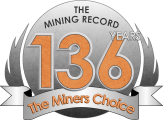High-Grade Zone Revealed At The Gaspe Copper Project
MONTREAL – Osisko Metals Incorporated, CEO Robert Wares, said, “The growth potential of the Gaspé Copper deposit, located in the Gaspé Peninsula of Eastern Québec, continues to be demonstrated with new high-grade results. Holes 30-1106 and 30-1109 reveal the presence of a thick, higher grade tabular zone lying at depth around the E Zone horizon near the eastern margin of our 2024 MRE model. This tabular zone may extend significantly to the east if it correlates to historical drilling results. Our expansion drilling is exceeding expectations, hand-in-hand with the solid infill results on our main resource area.”
Infill intercepts are located inside the 2024 MRE model, and are focused on upgrading inferred mineral resources to measured or indicated categories, as applicable. Expansion intercepts are located outside the 2024 MRE model and may potentially lead to additional resources that will be classified appropriately within the next MRE update. Some of the reported intercepts have contiguous shallower infill as well as deeper expansion.
Drill holes 30-1103 and 30-1108, both located near the western margin of the 2024 MRE model, cut multiple intersections of mineralized material, 20 to 168 metres thick, distributed in “layer cake” fashion from surface to a vertical depth of 854 and 900 metres, respectively.
Drill hole 30-1106, located near the eastern margin of the 2024 MRE model, cut unmineralized material to a depth of about 600 metres, followed by four mineralized intervals to a vertical depth of 1004 metres. These include a higher-grade interval of 33.8 metres averaging 1.04% Cu and 3.60 g/t Ag located at the level of (and immediately below) the E Zone skarn horizon.
Drill hole 30-1109, also located near the eastern margin of the 2024 MRE model, cut unmineralized material to a depth of about 460 metres, followed by three mineralized intervals to a vertical depth of 860 metres. These also include a higher-grade interval of 133.7 metres averaging 1.04% Cu and 6.48 g/t Ag located in skarn and porcellanites above and below the E Zone skarn horizon.
Both 30-1106 and 30-1109 suggest potential for the presence of a higher-grade tabular deposit around the E Zone horizon that, when combined with historical drilling data, indicates a potential extension eastward towards the previously mined E-32 Zone over a lateral distance of 800 metres.
Drill hole 30-1110, located on top of Copper Mountain near the central part of the 2024 MRE model, intersected 1091.5 metres averaging 0.20% Cu, 1.52 g/t Ag, and 0.017% Mo (0.28% CuEq), including 735.6 metres averaging 0.20% Cu, 1.50 g/t Ag, and 0.015% Mo (infill) and 355.9 metres averaging 0.21% Cu, 1.55 g/t Ag, and 0.021% Mo (expansion), extending mineralization to a vertical depth of 1100 metres and again confirming continuity of mineralization in the core of the deposit.
Drill hole 30-1111, located immediately west of Copper Mountain near the southern lip of the pit, intersected 304.5 metres (from surface) averaging 0.17% Cu and 0.80 g/t Ag followed by three more intersections that included expansion at depth of 206.3 metres averaging 0.33% Cu, 2.39 g/t Ag, and 0.016% Mo, extending mineralization in this area to a vertical depth of 936 metres. The central porphyry intrusion was then intersected and returned 76 metres averaging negligible copper (0.08% Cu) but significant molybdenum (0.023% Mo).
Mineralization at Gaspé Copper is of porphyry copper/skarn type and occurs as disseminations and stockworks of chalcopyrite with pyrite or pyrrhotite and minor bornite and molybdenite. At least five retrograde vein/stockwork mineralizing events have been recognized at Copper Mountain, which overprint earlier prograde skarn and porcellanite-hosted mineralization throughout the Gaspé Copper system. Porcellanite is a historical mining term used to describe bleached, pale green to white potassic-altered hornfels. Subvertical stockwork mineralization dominates at Copper Mountain whereas prograde bedding-replacement mineralization, that is mostly stratigraphically controlled, dominates in the area of Needle Mountain, Needle East, and Copper Brook. High molybdenum grades (up to 0.5% Mo) were locally obtained in both the C Zone and E Zone skarns away from Copper Mountain.
The 2022 to 2024 Osisko Metals drill programs were focused on defining open-pit resources within the Copper Mountain stockwork mineralization (see May 6, 2024 MRE press release). Extending the resource model south of Copper Mountain into the poorly-drilled prograde skarn/porcellanite portion of the system subsequently led to a significantly increased resource, mostly in the Inferred category (see November 14, 2024 MRE press release).
The current drill program is designed to convert the November 2024 MRE to Measured and Indicated categories, as well as test the expansion of the system deeper into the stratigraphy and laterally to the south and southwest towards Needle East and Needle Mountain respectively. The November 2024 MRE was limited at depth to the base of the L1 skarn horizon (C Zone), and all mineralized intersections below this horizon represent potential depth extensions to the deposit, to be included in the next scheduled MRE update in Q1 2026.
All holes are being drilled sub-vertically into the altered calcareous stratigraphy, which dips 20 to 25 degrees to the north. The L1 (C Zone) the L2 (E Zone) skarn/marble horizons were intersected in most holes, as well as intervening porcellanites that host the bulk of the disseminated copper mineralization.
Related Posts
VANCOUVER - Homeland Uranium Corp. reported on the Phase II exploration drilling program at the…
VANCOUVER - Domestic Metals Corp. has received analytical results for 310 surface samples from the…
VANCOUVER - Antimony Resources Corp. reported the latest set of High-Grade antimony (Sb) assays from…



